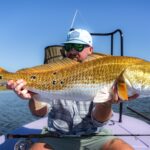
Louisiana Bull Reds Up for Harvest Again: H.B. 604 Must Not Pass
Photo Credit: Carter Abramson | Trevor Johnson Every now and then, we encounter something so
We don’t want to be tone-deaf on the major issue at hand, However, life must go on and we still have to keep everyone informed on fisheries management issues.
The Atlantic States Marine Fisheries Commission (ASMFC) will hold its next meeting on May 5th-6th via webinar. Both days will cover some important topics from herring to menhaden and striped bass to bluefish. For striped bass anglers, the part to watch will be the Atlantic Striped Bass Management Board meeting from 3-4PM on May 5th.
We’ll be closely watching the discussion on predicted fishery performance in 2020, especially given what we read in a recent memo to the Striped Bass Management Board:
However, the predicted 18% reduction in total removals was calculated assuming all states would implement consistent measures for the ocean and Chesapeake Bay. With different measures implemented in different states, the total overall predicted reduction would likely differ from the 18% originally calculated for the coastwide measure
Conservation equivalency (CE) strikes again. The use of CE in Addendum VI will lead to a lower-than needed-reduction in removals (harvest plus mortality from catch-and-release). We were supposed to achieve 18%. The Technical Committee recalculated with CE and we will only hit a 15% reduction. After all those emails and comments everyone sent in, we still miss the mark.
Amendment VI (2003) for striped bass management laid out five triggers to ensure stock stability. Trigger one says that if the fishing mortality threshold is exceeded in any year, the Board must reduce the fishing mortality rate to a level that is at or below the target within one year. By only achieving a 15% reduction, there is a less than 50% chance the fishing mortality (F) will be reduced as directed by the management trigger.
Here’s the kicker (also from the memo) and we will explain why.
Overall, however, the implementation of CE measures did not significantly undermine the Board’s efforts to end overfishing and reduce F to the F target in 2020.
However, the TC stresses that these calculations are done with the assumption that fishing effort and fish availability will be similar to 2016‐2017. Removals in 2018 and 2019 were significantly lower than 2017, even under the same regulations, which is always a source of uncertainty in recreational bag and size limit analyses. More importantly, the impact of COVID‐19 on total removals in 2020 cannot be predicted
We aren’t sure how that assumption can be made. Striped bass were still spawning as of yesterday and Maryland’s trophy season started on May 1. Trophy season harvest will likely be higher than the last few years. Raritan Bay off New York/New Jersey has seen quite a few boats fishing for striped bass as well.
All the while, due to COVID-19 there are almost no dockside intercept surveys occurring for the Marine Recreational Information Program (MRIP), which are used to estimate recreational catch. It is hard to interview returning anglers and achieve social distancing. The spring of 2020 will be a black hole for data on striped bass.
This is the most important part of the meeting. ASMFC will attempt to form a striped bass work group to discuss potential management changes for the species. Here is a list of possible changes included in the aforementioned memo:
These motions consider (1) accountability measures for Addendum VI (i.e., if a state does not hit its predicted target reduction in 2020) and (2) initiating an Amendment to revisit and address several management issues including fishery goals and objectives, reference points, management triggers, stock rebuilding, area‐specific management, and commercial allocation. Additionally, during Addendum VI deliberation in February, the Board also expressed intent to revisit the conservation equivalency provision and to pursue accountability measures for recreational striped bass fisheries in the future
We are very concerned with some of the potential changes to striped bass management. Namely: fishery goals and objectives; reference points; management triggers; stock rebuilding; and area‐specific management.
Trust us, if formed, the work group will not work on higher reference points or more management triggers to ensure long-term health of the stock. This work group will lay the groundwork for everything we have been warning you about. Lowering reference points, considering the Delaware Bay and Chesapeake Bay stocks separate from the coastal stock (huh?), and altering the goals and objectives for striped bass management.
While we appreciate the fact that the ASMFC wants to forge ahead and figure out a way to work during these crazy times, it also doesn’t feel right to be doing this now. How can the public be engaged in the process when many of them are trying to figure out how to still pay their mortgage?
Our gut instinct must be spot-on because as you read through the material your run across this gem of a quote.
This would allow work to continue on these important issues without excluding any ideas and to allow for transparency in addressing ongoing management issues to the extent practical during these challenging times.
To the extent practical? What exactly is practical at this point? I am currently fattening up the neighborhood squirrels just in case things get really bad.
Seriously though, just like we said in the beginning of the blog, there is an element of being tone deaf-here. We are fisheries professionals and barely have time to lock horns on this. What’s the average guide doing right now? Like many Americans, they are trying to save their businesses. Maybe now isn’t the best time to try and make significant changes to striped bass management?

Photo Credit: Carter Abramson | Trevor Johnson Every now and then, we encounter something so

This past weekend, ASGA proudly sponsored the Dirty Carp Tournament in Louisiana — and no, you didn’t misread that.

After years of data pouring in from The Albie Project, advocacy, persistence, and support from

This morning, the Connecticut Environment Committee held a hearing on House Bill 6248, a bill
We rely on our members and donations to keep fighting for a sustainable tomorrow in marine conservation.
GIVE THE GIFT OF FISHERIES CONSERVATION THIS HOLIDAY SEASON. SHOP ASGA GOODS THAT FUND FISHERIES RESEARCH & ADVOCACY CAMPAIGNS
JOIN ASGA IN CALLING FOR CRITICAL MANAGEMENT ACTION AFTER YEARS OF SPAWN FAILURES & POOR MANAGEMENT.
By using this website, you agree to our use of cookies. We use cookies to provide you with a great experience and to help our website run effectively. To learn more, please review our privacy policy.
One Response
Now is the best time to make meaningful change.
While many of us are trying to stay afloat we have more time on our hands to help.
C-19 is killing business but if regs are relaxed we will have way more to worry about in coming years.